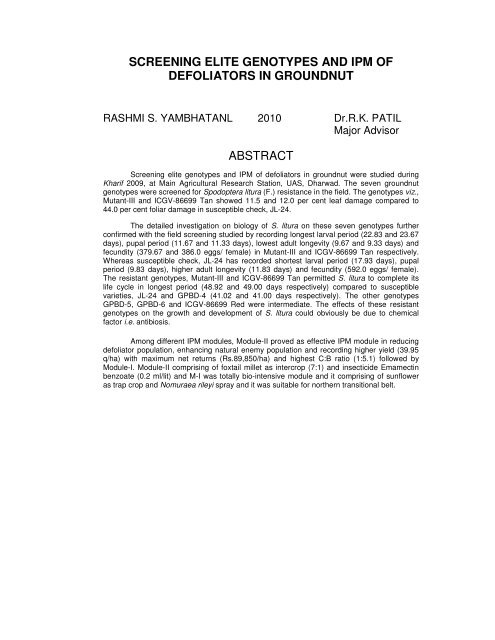screening elite genotypes and ipm of defoliators in groundnut
screening elite genotypes and ipm of defoliators in groundnut
screening elite genotypes and ipm of defoliators in groundnut
You also want an ePaper? Increase the reach of your titles
YUMPU automatically turns print PDFs into web optimized ePapers that Google loves.
SCREENING ELITE GENOTYPES AND IPM OF<br />
DEFOLIATORS IN GROUNDNUT<br />
RASHMI S. YAMBHATANL 2010 Dr.R.K. PATIL<br />
Major Advisor<br />
ABSTRACT<br />
Screen<strong>in</strong>g <strong>elite</strong> <strong>genotypes</strong> <strong>and</strong> IPM <strong>of</strong> <strong>defoliators</strong> <strong>in</strong> <strong>groundnut</strong> were studied dur<strong>in</strong>g<br />
Kharif 2009, at Ma<strong>in</strong> Agricultural Research Station, UAS, Dharwad. The seven <strong>groundnut</strong><br />
<strong>genotypes</strong> were screened for Spodoptera litura (F.) resistance <strong>in</strong> the field. The <strong>genotypes</strong> viz.,<br />
Mutant-III <strong>and</strong> ICGV-86699 Tan showed 11.5 <strong>and</strong> 12.0 per cent leaf damage compared to<br />
44.0 per cent foliar damage <strong>in</strong> susceptible check, JL-24.<br />
The detailed <strong>in</strong>vestigation on biology <strong>of</strong> S. litura on these seven <strong>genotypes</strong> further<br />
confirmed with the field <strong>screen<strong>in</strong>g</strong> studied by record<strong>in</strong>g longest larval period (22.83 <strong>and</strong> 23.67<br />
days), pupal period (11.67 <strong>and</strong> 11.33 days), lowest adult longevity (9.67 <strong>and</strong> 9.33 days) <strong>and</strong><br />
fecundity (379.67 <strong>and</strong> 386.0 eggs/ female) <strong>in</strong> Mutant-III <strong>and</strong> ICGV-86699 Tan respectively.<br />
Whereas susceptible check, JL-24 has recorded shortest larval period (17.93 days), pupal<br />
period (9.83 days), higher adult longevity (11.83 days) <strong>and</strong> fecundity (592.0 eggs/ female).<br />
The resistant <strong>genotypes</strong>, Mutant-III <strong>and</strong> ICGV-86699 Tan permitted S. litura to complete its<br />
life cycle <strong>in</strong> longest period (48.92 <strong>and</strong> 49.00 days respectively) compared to susceptible<br />
varieties, JL-24 <strong>and</strong> GPBD-4 (41.02 <strong>and</strong> 41.00 days respectively). The other <strong>genotypes</strong><br />
GPBD-5, GPBD-6 <strong>and</strong> ICGV-86699 Red were <strong>in</strong>termediate. The effects <strong>of</strong> these resistant<br />
<strong>genotypes</strong> on the growth <strong>and</strong> development <strong>of</strong> S. litura could obviously be due to chemical<br />
factor i.e. antibiosis.<br />
Among different IPM modules, Module-II proved as effective IPM module <strong>in</strong> reduc<strong>in</strong>g<br />
defoliator population, enhanc<strong>in</strong>g natural enemy population <strong>and</strong> record<strong>in</strong>g higher yield (39.95<br />
q/ha) with maximum net returns (Rs.89,850/ha) <strong>and</strong> highest C:B ratio (1:5.1) followed by<br />
Module-I. Module-II compris<strong>in</strong>g <strong>of</strong> foxtail millet as <strong>in</strong>tercrop (7:1) <strong>and</strong> <strong>in</strong>secticide Emamect<strong>in</strong><br />
benzoate (0.2 ml/lit) <strong>and</strong> M-I was totally bio-<strong>in</strong>tensive module <strong>and</strong> it compris<strong>in</strong>g <strong>of</strong> sunflower<br />
as trap crop <strong>and</strong> Nomuraea rileyi spray <strong>and</strong> it was suitable for northern transitional belt.
















